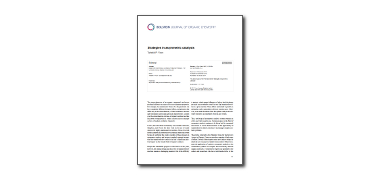Search results
Search for "sensors" in Full Text gives 186 result(s) in Beilstein Journal of Organic Chemistry.
Synthesis and binding studies of two new macrocyclic receptors for the stereoselective recognition of dipeptides
Beilstein J. Org. Chem. 2010, 6, No. 5, doi:10.3762/bjoc.6.5
- receptors for the selective binding of short oligopeptides has potential applications in the development of diagnostic sensors, separation techniques, and therapeutic agents. With respect to this latter point, there is a significant interest in the advance of receptors that selectively bind the D-Ala-D-Ala
Control of stilbene conformation and fluorescence in self-assembled capsules
Beilstein J. Org. Chem. 2009, 5, No. 79, doi:10.3762/bjoc.5.79
- a fully reversible process with long chain alkane guests. We are currently pursuing this application with stilbenes and studying the exchange of subunits in the process [12][13]. Many fluorescent sensors have been reported in the literature [14][15][16][17], however they usually respond to chemical
Flow through reactors for organic chemistry: directly electrically heated tubular mini reactors as an enabling technology for organic synthesis
Beilstein J. Org. Chem. 2009, 5, No. 70, doi:10.3762/bjoc.5.70
- well-controlled electromagnetic field generation. Cheap thermocouples cannot be used as sensors for temperature measurement and control. Temperature sensors cannot always be fixed directly into the reaction mixture because of limited chemical or mechanical stability. Operation under high pressure is
An expedient and new synthesis of pyrrolo[1,2-b]pyridazine derivatives
Beilstein J. Org. Chem. 2009, 5, No. 66, doi:10.3762/bjoc.5.66
- ; tertiary butyl carbamate; tertiary butyl carbazate; α,β-unsaturated ketone; Introduction Pyrrolopyridazine derivatives have various biological applications [1][2][3][4][5][6][7][8], and their fluorescent properties have been investigated for potential use in sensors, lasers, and semiconductor devices [9
Synthesis and properties of calix[4]arene telluropodant ethers as Ag+ selective sensors and Ag+, Hg2+ extractants
Beilstein J. Org. Chem. 2009, 5, No. 59, doi:10.3762/bjoc.5.59
- +-selective ionophores in ion-selective electrodes evaluated by electromotive force measurements of polymer membrane electrodes. The tweezer-like ionophores 6–8 showed excellent extraction ability towards Ag+ and Hg2+. Keywords: calix[4]arenes; extractants; mercury; sensors; silver; telluropodant ether
- ; Introduction There is much interest in the development of compounds that selectively respond to specific metal ions for use as ion sensors. As the third generation of supramolecule, benefiting from their three-dimensional structures and easy chemical modification both at the upper- and lower-rims as well as
- their potential receptor properties for cations, anions and neutral molecules, calixarenes have enjoyed widespread use in various areas of science and technology. One of their successful applications as sensors is in analytical chemistry. They are useful for separations, enrichment, and analyses of
Novel banana-discotic hybrid architectures
Beilstein J. Org. Chem. 2009, 5, No. 52, doi:10.3762/bjoc.5.52
- applications such as one-dimensional conductors, photoconductors, light emitting diodes, photovoltaic solar cells, gas sensors etc. [10][11][12][13][14][15][16][17][18][19][20][21]. The functional capabilities of these materials are due to their easier processibility, spontaneous alignment between electrodes
Progress in liquid crystal chemistry
Beilstein J. Org. Chem. 2009, 5, No. 48, doi:10.3762/bjoc.5.48

- organic light emitting diodes, photovoltaic devices, organic field effect transistors, gas sensors etc. [3][4][5][6][7][8]. One of the major issues in liquid crystal research today is still the poor knowledge of structure-property relationships and thus the synthesis of whole series of structurally
Quinoline based receptor in fluorometric discrimination of carboxylic acids
Beilstein J. Org. Chem. 2008, 4, No. 52, doi:10.3762/bjoc.4.52
- for online and real-time analyses [4]. A large number of examples of fluorescent sensors capable of sensing ions and molecules have appeared over the past few years [5][6][7]. In this context, fluorescent sensors, which rely on guest-induced folding of flexible receptors bringing the fluorophore
One-pot preparation of substituted pyrroles from α-diazocarbonyl compounds
Beilstein J. Org. Chem. 2008, 4, No. 45, doi:10.3762/bjoc.4.45
- ][11], electronics [12], gas sensors for organic compounds [13], and as building blocks in many physiologically interesting natural products, such as alkaloids [14]. The classical methods of constructing pyrrole ring system include mainly Knorr or Paal–Knorr syntheses, which have been summarized in a
Synthesis of deep- cavity fluorous calix[4]arenes as molecular recognition scaffolds
Beilstein J. Org. Chem. 2008, 4, No. 36, doi:10.3762/bjoc.4.36
- have included nanowires [3], self organized nanostructures [4] chiral supramolecular assemblies [5], as well as sensors for cations [6][7], anions [8] and neutral organic molecules [9]. The versatility of the calixarene scaffold is a result of its preorganized cavity [10], which consists of four
- recyclable reagents [18] to the total synthesis of natural products [19]. Fluorous compounds are the basis for highly selective ion sensors that show promise by virtue of their low level of biofouling [20]. Recently, it was shown that simple fluorous compounds act as molecular receptors for selective
- are locked in the cone conformation have been synthesized. These molecules are soluble in several fluorous solvents, and show promise as fluorescent sensors. Introducing the hydroxyl functionality onto these molecules provides a scaffold with a deep cavity and hydrogen bonding functional groups for
Beilstein Journal of Organic Chemistry
Beilstein J. Org. Chem. 2005, 1, No. 1, doi:10.1186/1860-5397-1-1

- : para-biologies built, just like the original kind, out of organic chemistry. The synthesis of molecular motors, or sensors, of springs and levers makes possible this new molecular engineering at the nanometre scale for eventual uses which only the future will tell. Expanding scientific horizons are







































































